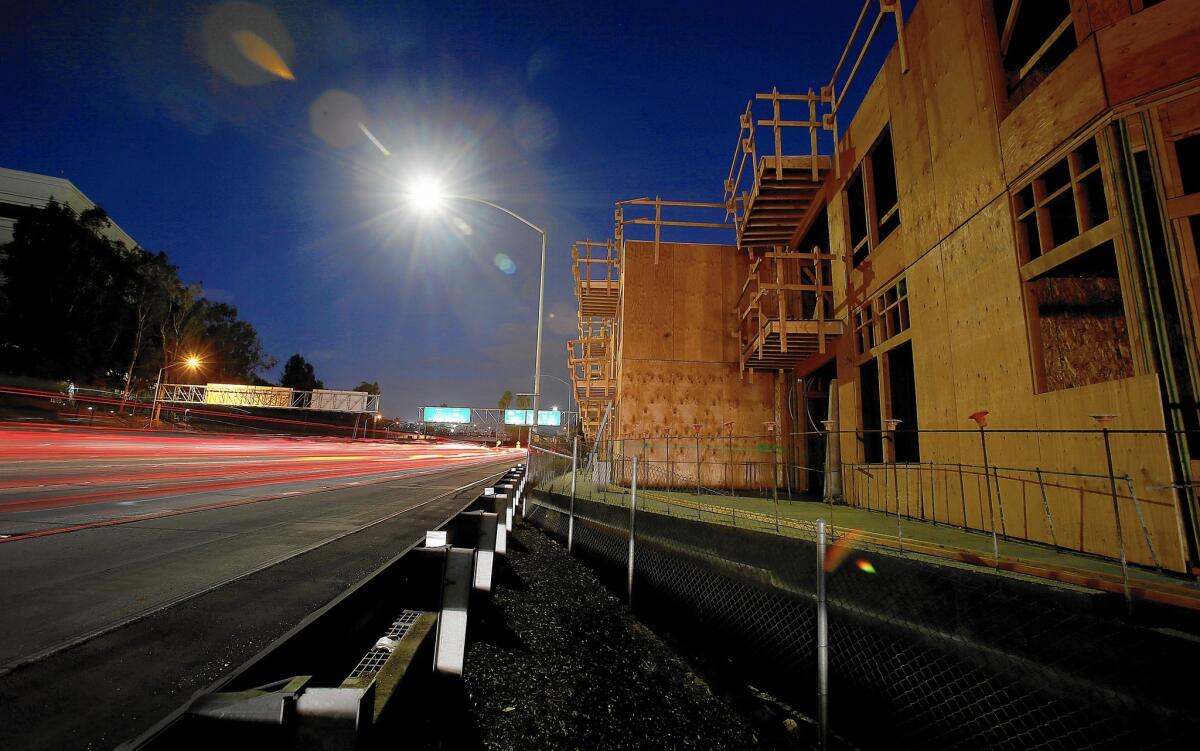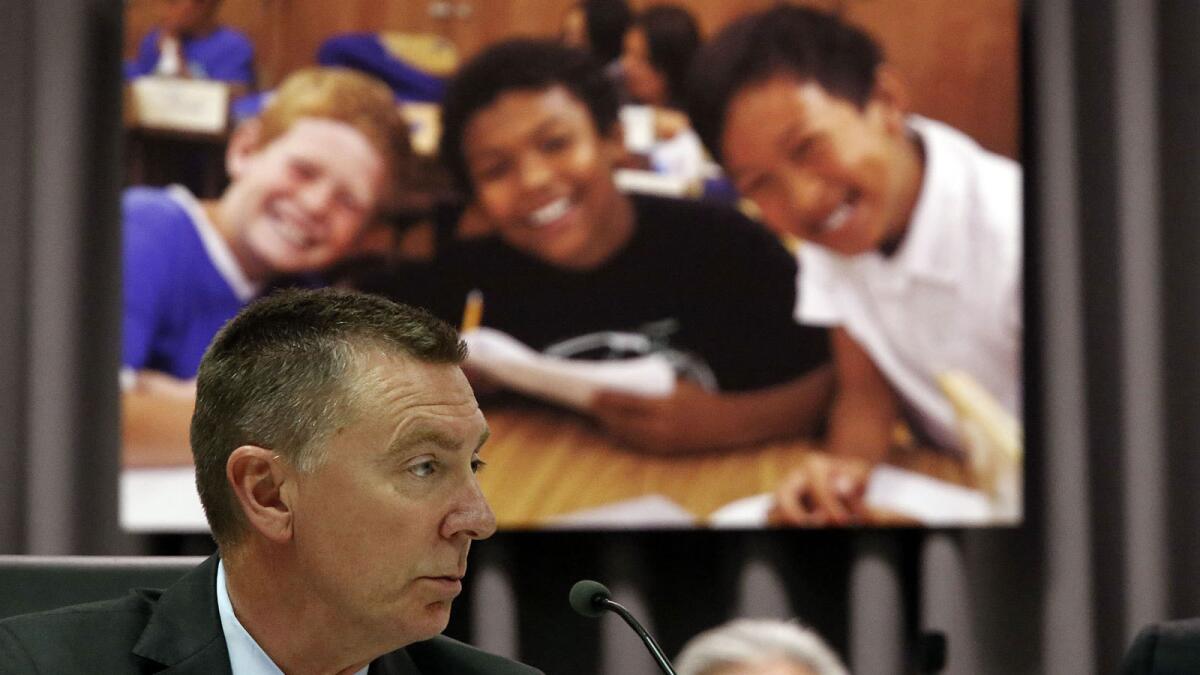Newsletter: Quakes, fires and drought in this week’s Essential California
- Share via
Preparing for Quakes, Rethinking Where to Build and Looking for Hope at LAUSD
Welcome to the Essential California newsletter this week. I’m Shelby Grad, The Times’ California editor.
Not Waiting for the Big One
It typically takes a major earthquake to move seismic safety to the top of the agenda. After the 1971 Sylmar quake, Los Angeles mandated the retrofitting of brick buildings. The 1989 Loma Prieta quake brought improvements to California freeways. Now Los Angeles is poised to consider the most sweeping seismic rules in its history, under the premise that we should not sit and wait for another catastrophic quake.
Mayor Eric Garcetti this week proposed mandatory retrofitting for two types of structures that experts say are at the greatest risk of collapse in large quakes: concrete buildings and wooden apartments that have weak first stories. There are thousands of these across the city, including the mid-rise office towers along Wilshire Boulevard and the boxy apartment houses with first-story carports that dot the residential landscape.
Garcetti’s ambitious plan is likely to face opposition from many property owners and renters, who undoubtedly will bear some of the costs. But there appears to be support on the City Council.
Read the full Times series on earthquake safety here.
Freeway-Close Apartment Fire Stokes Debate
The fire at the Da Vinci complex highlighted the controversial trend of building dense dwellings alongside freeways. You see such apartments as you drive along the 405 on the Westside and in the Valley and along the 5 in Lincoln Heights. The Da Vinci’s developer, Geoffrey H. Palmer, has built an empire of large, upscale apartment complexes across downtown L.A.

The Da Vinci, next to the Harbor Freeway, under construction in September. (Luis Sinco / Los Angeles Times) Read more
With available land increasingly scarce in Southern California, building next to freeways might make financial sense. But air-quality experts have
A Very Bad Year for L.A. Unified
It’s clear that 2014 is going down as a tough year for the Los Angeles Unified School District. The debacle over the failed iPad program – and now an

John Deasy, shown at a Board of Education meeting in August, came under fire for the iPad program. (Gary Friedman / Los Angeles Times) Read more
But Steve Lopez reminds us that if you look deeper, there is much about the LAUSD to offer hope: “For all the distractions, most teachers and principals care about their jobs and do them well, and students have continued to show gains in recent years. And as for graduation rates and go-to-college rates, UCLA education professor John Rogers says the numbers ‘seem to have improved significantly.’” Lopez
Drought Disrupts Gardeners
Even with this week’s rains, times are tough for California gardeners. The drought has proved to be a disruptive force for those in the landscaping business as lush gardens are replaced by low-water, low-maintenance planting. Esmeralda Bermudez talks to gardeners about how they are – at times grudgingly – learning about drought-tolerant plants. One gardener, Alberto Ortega, is studying books and the Internet on the subject. “It hurts to go back after so many years, but I have to. Later on, we may find this is a blessing in disguise.”

Elias Hernandez, on the maintenance team with landscaping firm FormLA in Tujunga, sweeps the drought-resistant plantings at a Los Angeles client's home. (Al Seib / Los Angeles Times) Read more
Why Can’t L.A. Count Bikes?
The mantra at City Hall (and other halls of government) is to use data to help make major policy decisions. But what happens when you lack the data?
L.A. has installed more than 100 miles of bicycle lanes in recent years and plans to add or upgrade more than 1,000 miles more in the coming decade. Our weekly California Commute feature points out a problem: The city has no comprehensive way to analyze whether or how the added lanes have increased cycling. Counting bikes is possible: San Francisco and Santa Monica have been doing so for several years. And The Times published a data analysis this month that showed that the number of hit-and-runs between cars and bicycles has surged with the addition of bike lanes.
Finally, Here Are Some Great Reads for Your Weekend:
– In a Central Valley hamlet hit especially hard by drought, Diana Marcum looks at the delicate negotiation among neighbors trying to get through it together.
– The mobile Web holds much promise to help those with healthcare needs in rural, isolated areas. A big barrier: poor cellphone and Internet service.
– The presence of a military gun dealer has generated outrage in Leimert Park.
– California prepares to issue driver’s licenses to immigrants who are here illegally.
– The Bay Area is a hotbed for protests – and they have a tendency to get out of hand.
– David Zahniser explores the political sausage making that comes with deciding whether to remove billboards in L.A.
– Here’s a fascinating history on the freeway sound wall.
– The Desert Sun offers a spirited retrospective on the mob during Palm Springs’ rat pack era.
Sign up for Essential California
The most important California stories and recommendations in your inbox every morning.
You may occasionally receive promotional content from the Los Angeles Times.

![Vista, California-Apri 2, 2025-Hours after undergoing dental surgery a 9-year-old girl was found unresponsive in her home, officials are investigating what caused her death. On March 18, Silvanna Moreno was placed under anesthesia for a dental surgery at Dreamtime Dentistry, a dental facility that "strive[s] to be the premier office for sedation dentistry in Vitsa, CA. (Google Maps)](https://ca-times.brightspotcdn.com/dims4/default/07a58b2/2147483647/strip/true/crop/2016x1344+29+0/resize/840x560!/quality/75/?url=https%3A%2F%2Fcalifornia-times-brightspot.s3.amazonaws.com%2F78%2Ffd%2F9bbf9b62489fa209f9c67df2e472%2Fla-me-dreamtime-dentist-01.jpg)





